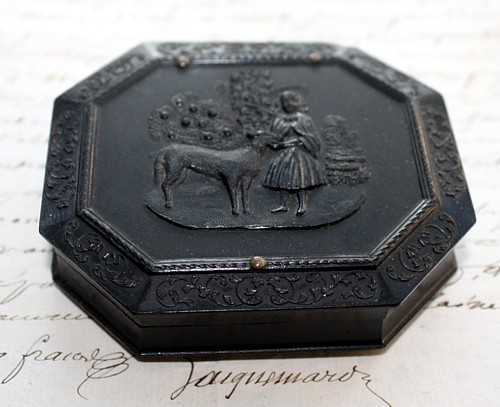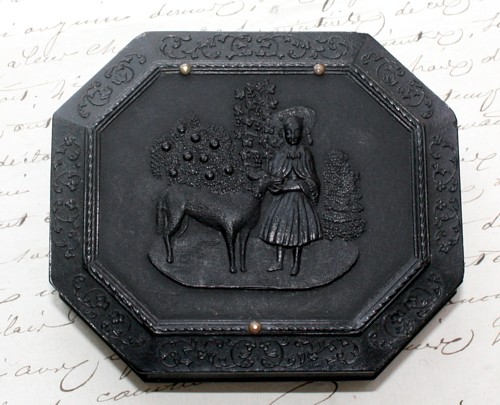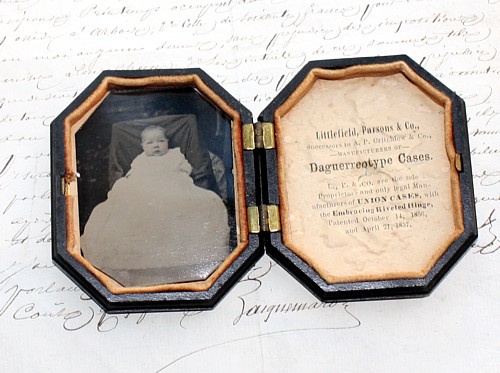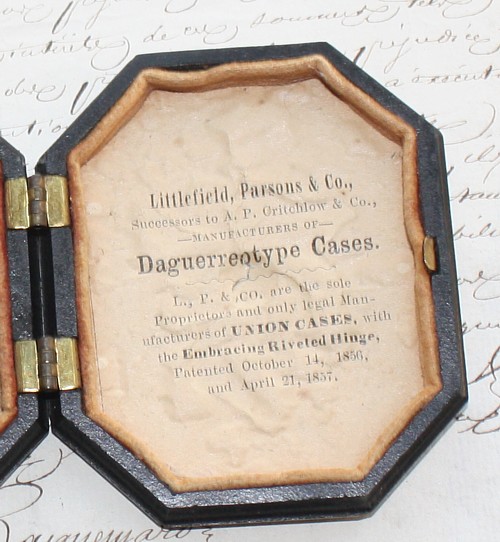Daguerreotypes are widely regarded as the most detailed and the most beautiful of all photographs, their life-like clarity is astonishing. Daguerreotypes were invented in 1837 by a Frenchman, Louis-Jacques-Mandé Daguerre, and revealed to the world in 1839 when the French government gave him a lifetime pension in exchange for his agreement to not patent them. You will be able to recognize a Daguerreotype because they are shiny, and reflect like mirrors. {you can actually see yourself in one!}

Mr. Daguerre had already patented them in England and Wales, only days before the French government’s grant, so early English Daguerreotypes were generally only made by a few licensed studios there, but in the United States and the rest of Europe, thousands of photographers set up studios. By the 1860’s other processes were invented because of the expense and labor intensiveness of the Daguerreotype.

Little cases were made to house the newly popular photographs {daguerreotypes, ambrotypes etc} made of wood covered in tooled leather. In the 1850s a newly invented thermoplastic made from shellac and finely ground sawdust became very popular because cases made from it could be elaborately engraved and die-pressed. This material was called Composition or Union, depending on whose competing patent was used, and the cases themselves became known as Union cases. They were made in the most beautiful designs, finding them in good condition is quite rare, many have cracked and chipped over the decades.

This is the sweetest Union Case I have ever seen, made by the Littlefield, Parsons & Co., which started producing thermoplastic Union Cases under that company name in 1858. {The company produced more new thermoplastic case designs than any other; greater than 390 are currently recorded.} This little treasure features an exquisite design of a little girl petting a lamb, or a large dog, on both sides of the case, surrounded by a lush garden with an apple tree, and grapevines. She is wearing a straw bonnet, cape, and clothing of the 1800’s.
Most often these cases have been referred to as “gutta percha”, which is incorrect, as according to experts no known photographic case has ever been proven to have been made of this substance, they are made of thermoplastic.

It is missing the little gold-colored mat and foil preservers called Pinchbeck after its inventor, Christopher Pinchbeck, but this doesn’t take away from this sweet little piece.

I love these, and any time I can find one, I buy it! This particular Daguerrotype Case is available at FrenchGardenHouse Here .
If you want to romance your Home and Garden with antique and vintage treasures to make you smile each time you come home, visit our shop FrenchGardenHouse.

 Your Cart
Your Cart
How sweet, I would say it is a lamb, but then again I might be partial
I think you are right, it’s a Lamb! Dana, your ribbonwork is gorgeous!
So what are they worth? And what if I had one that’s older and square but with same image? And has the symbol on left side that this one doesn’t? I can’t find it anywhere! This is only place I’ve found same image even
How much is this worth? And how do I get one almost the same but square shaped and has the symbol on inside left that this one doesn’t? Can’t find it on web anywhere! This is close as I’ve found and it’s not the same just same image
Last comment is suppose to ask how I get it appraised
Tracy, if you truly want to know what yours is worth, you should have a professional appraiser look at it for you. For a fee, they will tell you what your case is worth.